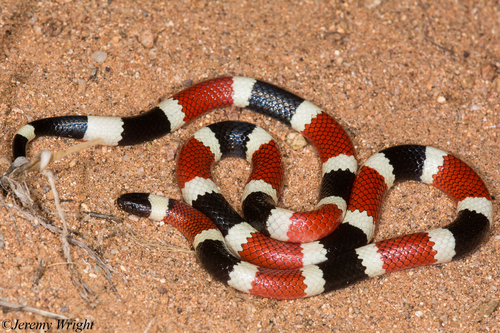
Sonoran Coral Snake
The Sonoran coral snake, Micruroides euryxanthus, flaunts vivid red, yellow, and black stripes, slinking through southwestern deserts. Nocturnally active and elusive, it wields potent venom yet poses minimal threat to humans. This snake is a key predator, balancing ecosystems by preying on small mammals and reptiles.
Length: 33 - 61 cm
Size
Yellow, Red, Black, White, Cream
Color
Low
Aggression
Least Concern
Conservation Status
Stable
Population Trend
Characteristics
Micruroides euryxanthus, commonly known as the Sonoran coral snake, is a small, brightly colored snake native to the deserts and scrublands of the southwestern United States and northwestern Mexico. It is distinguished by its striking red, yellow, and black banding. The species is nocturnal, often hiding under rocks or in burrows during the day. Despite its potent venom, it is non-aggressive and rarely bites humans. The snake plays an important ecological role by controlling the populations of small rodents and other snakes.
Distribution Range of the Sonoran Coral Snake
Micruroides euryxanthus, commonly known as the Sonoran coral snake, is native to the southwestern United States and northwestern Mexico. It is primarily found in the Sonoran Desert, covering regions in Arizona and parts of New Mexico in the USA, as well as the Mexican states of Sonora and northern Sinaloa.
Sonoran Coral Snake's Habitat
Environmental Conditions
The Sonoran coral snake inhabits arid and semi-arid regions characterized by desert and scrubland environments. These areas experience hot, dry conditions with limited precipitation. The vegetation typically includes cacti, thorny shrubs, and sparse grasses. The species prefers sandy or rocky soils where it can easily burrow.
Ecological Niche
Micruroides euryxanthus is a fossorial species, meaning it spends a significant portion of its life underground. It is primarily nocturnal, emerging at night to hunt for small reptiles and amphibians, which form the bulk of its diet. Its bright coloration serves as a warning to potential predators of its venomous nature. The snake plays a role in controlling the populations of its prey species, maintaining ecological balance within its habitat.
Copyright @ Nature Style Limited. All Rights Reserved.
 English
English